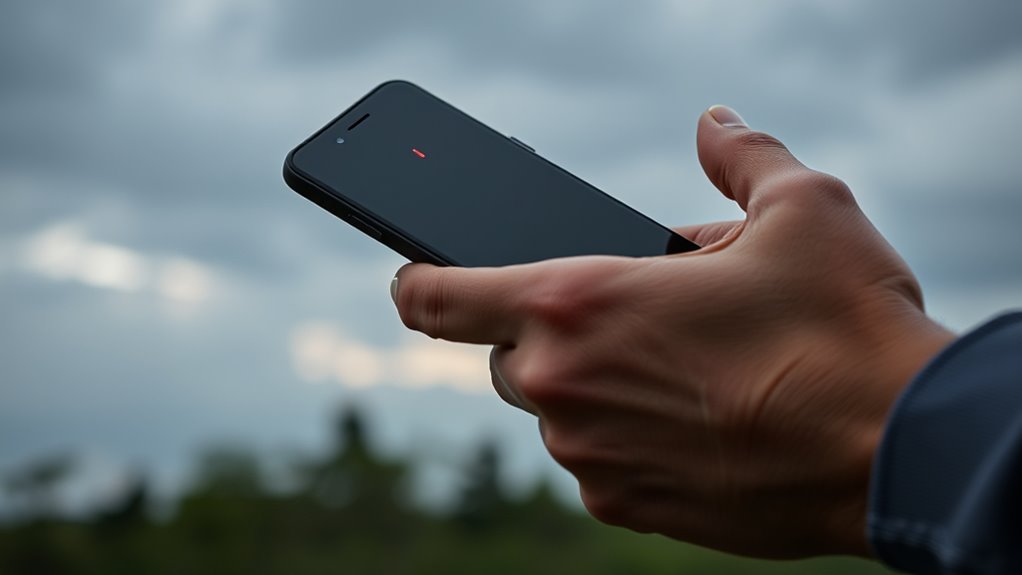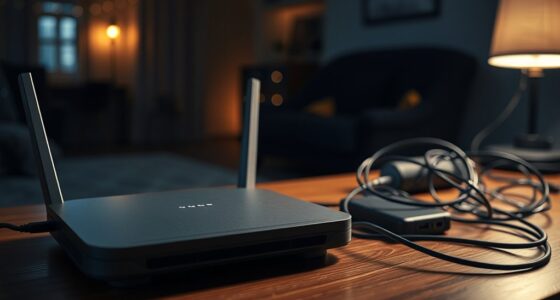To conserve your cell phone battery during emergencies, turn on power-saving mode, dim the screen, and close unnecessary apps. Limit notifications and disable Bluetooth, Wi-Fi, and location services when not needed. Use airplane mode when access isn’t urgent to save energy, and keep your device’s software updated for efficiency. Carry portable chargers or external batteries as backup. Following these tips guarantees your phone stays functional longer, and there’s more to explore for maximizing your device’s endurance.
Key Takeaways
- Enable power-saving mode and disable unused connectivity features like Bluetooth, Wi-Fi, and location services.
- Close background apps and disable notifications to reduce screen wake-ups and background activity.
- Limit non-essential functions such as video streaming or gaming to conserve battery life.
- Carry fully charged external power banks or portable chargers for backup during extended emergencies.
- Regularly monitor battery levels and prioritize essential communication to ensure device usability when needed.

When an emergency strikes, having a fully charged cell phone can be be a lifesaver, but battery life can quickly run out when you need it most. That’s why knowing effective power saving tips is essential to guarantee your device remains functional during critical moments. Your primary goal is to extend your battery’s life to maintain emergency communication whenever you need it. To do this, start by reducing screen brightness and turning off features like Bluetooth, Wi-Fi, and location services when they’re not necessary. These functions drain power even when not actively in use, so disabling them can considerably conserve energy.
Next, enable power-saving mode, which most smartphones offer. This mode minimizes background activity, limits app refreshes, and adjusts performance to extend battery life. It’s a quick, effective way to stretch your remaining juice during an emergency. Additionally, close all unused apps that might be running in the background, as they continue to consume power even when you’re not actively using your phone. Check your app settings to disable background refresh and notifications for non-essential apps, freeing up resources and saving battery.
Enable power-saving mode and close unused apps to conserve battery during emergencies.
Another useful tip involves managing notifications. Limit alerts to only critical messages from emergency services or family members. Constant notifications can wake your screen repeatedly, wasting battery. If your phone has an “airplane mode” option, consider turning it on when you don’t need to make calls or access the internet, but only do so if you’re confident you won’t need immediate communication. Remember, though, that this will disable most connectivity, so turn it off quickly if you need to reach someone or receive important updates.
Keep your phone’s software updated, as manufacturers often optimize power efficiency with updates. Avoid using power-intensive features like video streaming or gaming during emergencies, as they rapidly deplete your battery. Relying on power management tools can help optimize your device’s energy use further. Instead, rely on basic functions like calling, texting, or using essential emergency apps. Carrying a portable charger or power bank can also be a lifesaver, providing backup power when your device’s battery runs low.
Ultimately, conserving your cell phone’s battery during an emergency hinges on strategic power management. Implement these power saving tips early, and you’ll improve your chances of staying connected when it matters most. Remember, emergency communication is your lifeline, so every effort to extend your device’s battery life enhances your safety and peace of mind in critical situations. Staying mindful of your phone’s power and optimizing its settings can make all the difference when seconds count.
Frequently Asked Questions
Can I Extend Battery Life by Turning off Location Services?
Yes, turning off location services can extend your battery life. Location services often drain your battery fast because your device constantly searches for GPS signals. By disabling them, you improve battery optimization, which helps your phone last longer, especially during emergencies. Keep in mind, turning off location services may limit some app functionalities, but it’s a smart move when you need to conserve power quickly.
What Apps Drain Battery Fastest During Emergencies?
Apps like GPS navigation, streaming, and social media drain your battery faster than a wildfire spreads. During emergencies, focus on battery optimization by closing unnecessary apps and managing your app usage carefully. Turn off background updates and notifications for non-essential apps to conserve power. By actively managing your apps, you guarantee your phone stays powered longer when you need it most, keeping you connected and informed in critical moments.
Is It Better to Use Airplane Mode or Turn off the Phone Entirely?
It’s better to turn off your phone entirely to conserve maximum battery in emergencies. When you power down, all hardware components shut off, preventing power drain. Alternatively, activating power saving modes and hardware optimizations can extend your battery life while keeping your phone functional. These modes reduce background activity and limit features, but turning off the device guarantees no power is used, giving you the longest possible standby time until help arrives.
How Does Screen Brightness Impact Battery Conservation?
Think of your phone’s screen like a flashlight—bright light drains the battery faster. When you adjust brightness or turn on screen dimming, you’re effectively dimming that flashlight, conserving energy. Brightness adjustment reduces power consumption, especially when you lower the screen brightness. Using screen dimming in low-light environments can extend your battery life notably, ensuring your phone stays powered longer during emergencies or when you need it most.
Can Carrying a Portable Charger Effectively Prolong Emergency Communication?
Carrying a portable charger can effectively prolong your emergency communication by providing extra power when your phone’s battery runs low. It helps with battery management, ensuring you stay connected longer. Keep the portable charger charged and easily accessible, so you can quickly power up your phone when needed. This simple step boosts your reliability during emergencies, giving you peace of mind and a better chance to reach help or stay informed.
Conclusion
By conserving your cell phone battery during emergencies, you hold the key to staying connected when it matters most. Remember, your phone is a lifeline—think of it as a beacon in the dark. Use power wisely, enable essential features, and avoid unnecessary calls. In doing so, you guarantee that when help is needed, your device is ready to serve as your guiding light, illuminating the way through uncertainty. Protect your battery, protect your life.









